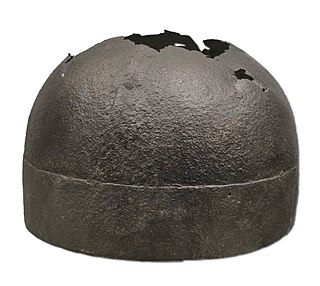
The Chi Rho is one of the earliest forms of the Christogram, formed by superimposing the first two (capital) letters—chi and rho (ΧΡ)—of the Greek word ΧΡΙΣΤΟΣ (Christos) in such a way that the vertical stroke of the rho intersects the center of the chi.

A cervelliere is a hemispherical, close-fitting skull cap of steel or iron. It was worn as a helmet during the medieval period and a version known as a secret was worn under felt hats during the Wars of the Three Kingdoms in the early modern period.

Charles du Fresne, sieur du Cange, also known simply as Charles Dufresne, was a distinguished French philologist and historian of the Middle Ages and Byzantium.
Châtelain was originally the French title for the keeper of a castle.

Late Latin is the scholarly name for the form of Literary Latin of late antiquity. English dictionary definitions of Late Latin date this period from the 3rd to the 6th centuries CE, and continuing into the 7th century in the Iberian Peninsula. This somewhat ambiguously defined version of Latin was used between the eras of Classical Latin and Medieval Latin. Scholars do not agree exactly when Classical Latin should end or Medieval Latin should begin.

A Christogram is a monogram or combination of letters that forms an abbreviation for the name of Jesus Christ, traditionally used as a religious symbol within the Christian Church.

Meghadūta is a lyric poem written by Kālidāsa, considered to be one of the greatest Sanskrit poets. It describes how a yakṣa, who had been banished by his master to a remote region for a year, asked a cloud to take a message of love to his wife. The poem became well-known in Sanskrit literature and inspired other poets to write similar poems on similar themes. Korada Ramachandra Sastri wrote Ghanavrttam, a sequel to Meghaduta

Johannes Meursius was a Dutch classical scholar and antiquary.

A Latin Dictionary is a popular English-language lexicographical work of the Latin language, published by Harper and Brothers of New York in 1879 and printed simultaneously in the United Kingdom by Oxford University Press.

Georg Anton Lorenz Diefenbach was a German philologist and lexicographer, as well as a novelist associated with the German Nationalist movement. By career he was a pastor, like his father, and a librarian.

Louis Thomassin was a French theologian and Oratorian.

Ite, missa est are the concluding Latin words addressed to the people in the Mass of the Roman Rite in the Catholic Church, as well as in the Divine Service of the Lutheran Church.
Nuntii Latini is the name of several news services that broadcast in Latin.

Abu Ishaq Ibrahim ibn Muhammad al-Farisi al-Istakhri was a 10th-century travel author and Islamic geographer who wrote valuable accounts in Arabic of the many Muslim territories he visited during the Abbasid era of the Islamic Golden Age. There is no consensus regarding his origin. Some sources describe him as Persian, while others state he was Arab. The Encyclopedia Iranica states: "Biographical data are very meager. From his nesbas he appears to have been a native of Eṣṭaḵr in Fārs, but it is not known whether he was Persian".

The spatharii or spatharioi were a class of Late Roman imperial bodyguards in the court in Constantinople in the 5th–6th centuries, later becoming a purely honorary dignity in the Byzantine Empire.

The Dictionary of Medieval Latin from British Sources ("DMLBS") is a lexicon of Medieval Latin published by the British Academy. The dictionary is not founded upon any earlier dictionary, but derives from original research. After decades of preparatory work, work on the dictionary itself was begun in 1965, and it was published in fascicules between 1975 and 2013. In 2016 the complete work was put online. A consolidated reprint in three volumes was published in 2018.

Joan Bastardas i Parera was a Spanish Latinist and Romance philologist, the son of the lawyer and politician Albert Bastardas i Sampere. He studied at the University of Barcelona, with Marià Bassols de Climent, and wrote a PhD dissertation on Medieval Latin syntax, for which he received the Antonio de Nebrija Prize (1951). He was also indirectly a student of the Swedish Latinist Dag Norberg.
Logeion is an open-access database of Latin and Ancient Greek dictionaries. Developed by Josh Goldenberg and Matt Shanahan in 2011, it is hosted by the University of Chicago. Apart from simultaneous search capabilities across different dictionaries and reference works, Logeion offers access to frequency and collocation data from the Perseus Project.
Neolithodes indicus is a species of king crab found in the Arabian Sea. It has been found at depths between 743–1,829 m (2,438–6,001 ft). It was originally identified erroneously as Lithodes agassizii by A.R.S. Anderson in 1896.
This page is based on this
Wikipedia article Text is available under the
CC BY-SA 4.0 license; additional terms may apply.
Images, videos and audio are available under their respective licenses.















